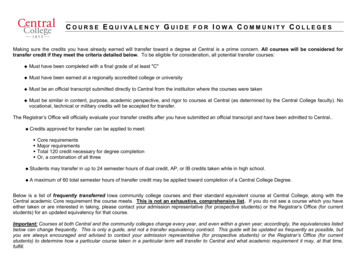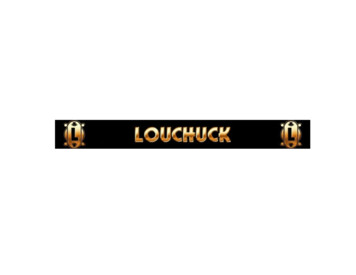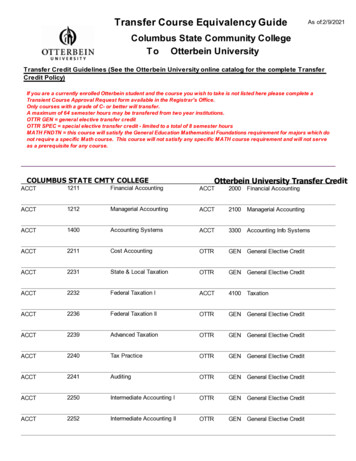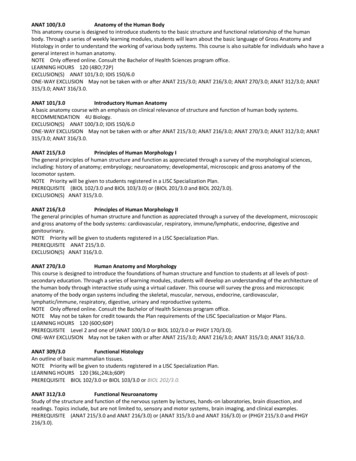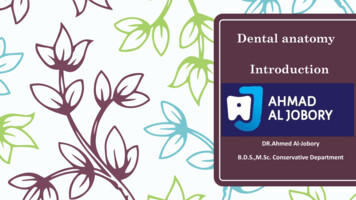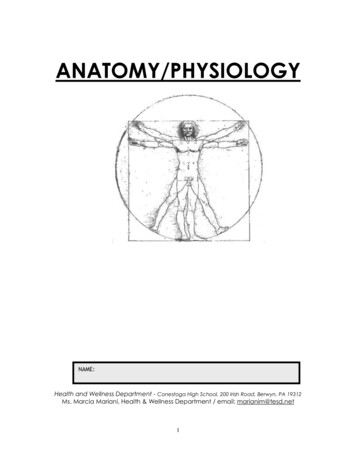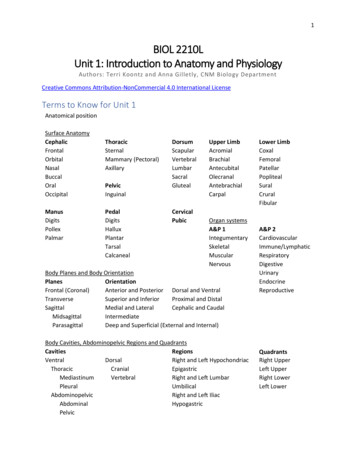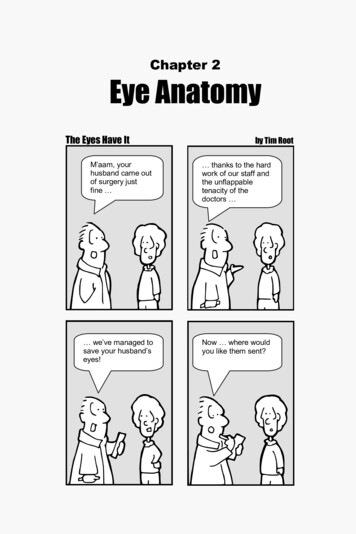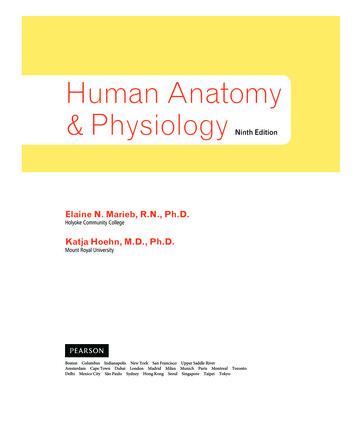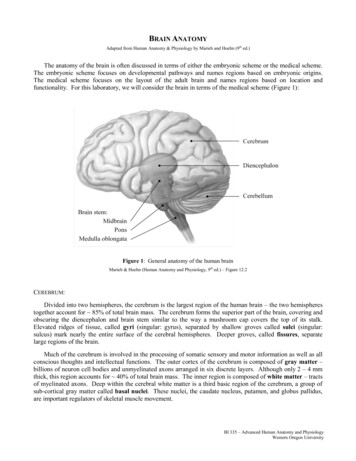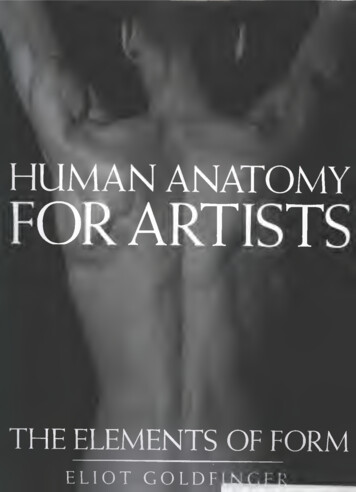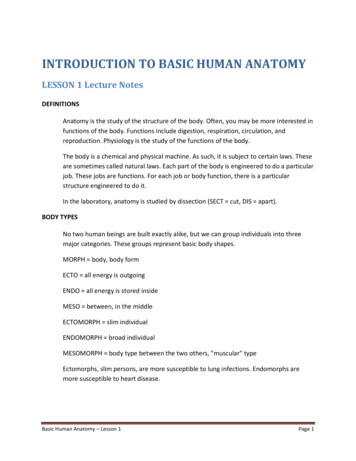
Transcription
INTRODUCTION TO BASIC HUMAN ANATOMYLESSON 1 Lecture NotesDEFINITIONSAnatomy is the study of the structure of the body. Often, you may be more interested infunctions of the body. Functions include digestion, respiration, circulation, andreproduction. Physiology is the study of the functions of the body.The body is a chemical and physical machine. As such, it is subject to certain laws. Theseare sometimes called natural laws. Each part of the body is engineered to do a particularjob. These jobs are functions. For each job or body function, there is a particularstructure engineered to do it.In the laboratory, anatomy is studied by dissection (SECT cut, DIS apart).BODY TYPESNo two human beings are built exactly alike, but we can group individuals into threemajor categories. These groups represent basic body shapes.MORPH body, body formECTO all energy is outgoingENDO all energy is stored insideMESO between, in the middleECTOMORPH slim individualENDOMORPH broad individualMESOMORPH body type between the two others, "muscular" typeEctomorphs, slim persons, are more susceptible to lung infections. Endomorphs aremore susceptible to heart disease.Basic Human Anatomy – Lesson 1Page 1
NOTE ON TERMINOLOGYEach profession and each science has its own language. Lawyers have legal terminology.Physicians and other medical professions and occupations have medical terminology,and educators have objectives, domains, and curricula.To work in a legal field, you should know the meaning of quid pro quo. To work in amedical field, you should know the meanings of terms such as proximal, distal, sagittal,femur, humerus, thorax, and cerebellum.KINDS OF ANATOMICAL STUDIESMicroscopic anatomy is the study of structures that cannot be seen with the unaidedeye. You need a microscope.Gross anatomy by systems is the study of organ systems, such as the respiratory systemor the digestive system.Gross anatomy by regions considers anatomy in terms of regions such as the trunk,upper member, or lower member.Neuroanatomy studies the nervous system.Functional anatomy is the study of relationships between functions and structures.ORGANIZATION OF THE HUMAN BODYThe human body is organized into cells, tissues, organs, organ systems, and the totalorganism.Cells are the smallest living unit of body construction.A tissue is a grouping of like cells working together. Examples are muscle tissueand nervous tissue.An organ is a structure composed of several different tissues performing aparticular function. Examples include the lungs and the heart.Organ systems are groups of organs which together perform an overall function.Examples are the respiratory system and the digestive system.The total organism is the individual human being. You are a total organism.Basic Human Anatomy – Lesson 1Page 2
Figure 1-1. Regions of the human body.REGIONS OF THE HUMAN BODYThe human body is a single, total composite. Everything works together. Each part actsin association with ALL other parts. Yet, it is also a series of regions. Each region isresponsible for certain body activities. These regions are:Basic Human Anatomy – Lesson 1Page 3
Back and Trunk. The torso includes the back and trunk. The trunk includes the thorax(chest) and abdomen. At the lower end of the trunk is the pelvis. The perineum is theportion of the body forming the floor of the pelvis. The lungs, the heart, and thedigestive system are found in the trunk.Head and Neck. The brain, eyes, ears, mouth, pharynx, and larynx are found in thisregion.Members. Each upper member includes a shoulder, arm, forearm, wrist, and hand. Eachlower member includes a hip, thigh, leg, ankle, and foot.ANATOMICAL TERMINOLOGYAs I mentioned earlier, you must know the language of a particular field to be successfulin it. Each field has specific names for specific structures and functions. Unless you knowthe names and their meanings, you will have trouble saying what you mean. You willhave trouble understanding what others are saying. You will not be able tocommunicate well.What is a scientific term? It is a word that names or gives special information about astructure or process. Some scientific terms have two or three different parts. Theseparts are known as a PREFIX, a ROOT (or base), and a SUFFIX. An example is the wordsubcutaneous.SUBCUTANEOUS means below the skin.SUB means below. SUB is the prefix.CUTIS means skin. CUTIS is the root.A second example is the word myocardium.MYOCARDIUM means the muscular wall of the heart.MYO means muscle. MYO is a prefix.CARDIUM means heart. CARDIUM is the root.A third example is the word tonsillitis.TONSIL is the rootITIS is the suffix and means inflammation.So TONSILLITIS means an inflammation of the tonsilsBasic Human Anatomy – Lesson 1Page 4
THE ANATOMICAL POSITIONThe anatomical position is an artificial posture of the human body (see figure 1-2). Thisposition is used as a standard reference throughout the medical profession.We always speak of the parts of the body as if the body were in the anatomical position.This is true regardless of what position the body is actually in. In the anatomicalposition, the body stands erect, with heels together. Upper members are along thesides, with the palms of the hands facing forward. The head faces forward.PLANES OF THE BODYSee figures 1-3A through 1-3C for the imaginary planes used to describe the body.Basic Human Anatomy – Lesson 1Page 5
Sagittal planes are vertical planes that pass through the body from front to back. Themedian or midsagittal plane is the vertical plane that divides the body into right and lefthalves.Horizontal (transverse) planes are parallel to the floor. They are perpendicular to boththe sagittal and frontal planes.Frontal (coronal) planes are vertical planes which pass through the body from side toside. They are perpendicular to the sagittal plane.Figure 1-3, A. The sagittal plane.Figure 1-3, B. The horizontal plane.Figure 1-3 C. The frontal plane.DIRECTIONSSuperior means above. Inferior means below.Anterior refers to the front of the body. A commonly-used substitute word is Ventral.Posterior refers to the back of the body. A commonly-used substitute word is Dorsal.Medial means toward or nearer the midline of the body.Lateral means away from the midline or toward the side of the body.Superficial means closer to the surface of the body.Basic Human Anatomy – Lesson 1Page 6
Deep means toward the center of the body or body part.Proximal and distal are terms applied specifically to the limbs. Proximal means nearer tothe shoulder joint or the hip joint. Distal means further away from the shoulder joint orthe hip joint. Sometimes proximal and distal are used to identify the "beginning" and"end" of the GI tract--that portion closer to the stomach being proximal while thatfurther away being distal.NAMESNames are chosen to describe the structure or process as much as possible. Aninternational nomenclature was adopted for anatomy in Paris in 1955. It does not usethe names of people for structures. (The single exception is the Achilles tendon at theback of the foot and ankle.)Names are chosen to identify structures properly. Names identify structures accordingto shape, size, color, function, and/or location. Some examples are:TRAPEZIUS MUSCLETRAPEZIUS trapezoid shaped, like a rectangle with uneven sides.ADDUCTOR MAGNUS MUSCLEAD towardDUCT to carry (function)MAGNUS very large (size)ERYTHROCYTEERYTHRO red (color)CYTE cellCELL INTRODUCTIONA cell is the microscopic unit of body organization. The "typical animal cell" is illustratedin figure 1-4. A typical animal cell includes a cell membrane, a nucleus, a nuclearmembrane, cytoplasm, ribosomes, endoplasmic reticulum, mitochondria, Golgiapparatus, centrioles, and lysosomes, and I’ll talk a little about each of them.Basic Human Anatomy – Lesson 1Page 7
Figure 1-4. A "typical" animal cell (as seen in an electron microscope).MAJOR COMPONENTS OF A "TYPICAL" ANIMAL CELLNucleus. The nucleus plays a central role in the cell. Information is stored in the nucleusand distributed to guide the life processes of the cell. This information is in a chemicalform called nucleic acids. Two types of structures found in the nucleus arechromosomes and nucleoli. Chromosomes can be seen clearly only during cell divisions.Chromosomes are composed of both nucleic acid and protein. Chromosomes containgenes. Genes are the basic units of heredity which are passed from parents to theirchildren. Genes guide the activities of each individual cell.Cell Membrane. The cell membrane surrounds and separates the cell from itsenvironment. The cell membrane allows certain materials to pass through it as theyenter or leave the cell.Cytoplasm. The semifluid found inside the cell, but outside the nucleus, iscalled the cytoplasm.Mitochondria (Plural). Mitochondria are the "powerhouses" of the cell. Themitochondria provide the energy wherever it is needed for carrying on the cellularfunctions.Basic Human Anatomy – Lesson 1Page 8
Endoplasmic Reticulum. The endoplasmic reticulum is a network of membranes,cavities, and canals. The endoplasmic reticulum helps in the transfer of materials fromone part of the cell to the other.Ribosomes. Ribosomes are "protein factories" in the cell. They are composed mainly ofnucleic acids which help make proteins according to instructions provided by the genes.Centrioles. Centrioles help in the process of cell division.Lysosomes. Lysosomes are membrane bound spheres which contain enzymes that candigest intracellular structures or bacteria.CELL MULTIPLICATION (MITOSIS)Individual cells have fairly specific life spans. Some types of cells have longer life spansthan others. During the processes of growth and repair, new cells are being formed. Theusual process of cell multiplication is called mitosis. There are two important factors toconsider: From one cell, we get two new cells. The genes of the new cells are identical (for all practical purposes) to the genesof the original cell.HYPERTROPHY/HYPERPLASIAHypertrophy and hyperplasia are two ways by which the cell mass of the bodyincreases.With HYPERTROPHY, there is an increase in the size of the individual cells. No new cellsare formed. An example is the enlargement of muscles due to exercise by the increaseddiameter of the individual striated muscle fibers.With HYPERPLASIA, there is an increase in the total number of cells. An example ofabnormal hyperplasia is cancer.ATROPHY is seen when there is a loss of cellular mass.Introduction to Basic Human Anatomy is a distance learning product that is based on theCorrespondence Subcourse MD0006 of the U.S. Army Medical Department Center and School.This presentation was produced by the Brookside Associates, Ltd., which is privately-held andnot connected to any governmental agency. The views expressed here are those of the authors,and unless otherwise noted, do not necessarily reflect the views of the Brookside Associates,Ltd., any governmental agencies or private organizations. This presentation is unclassified, and 2009, with all rights reserved.Basic Human Anatomy – Lesson 1Page 9
Basic Human Anatomy - Lesson 1 Page 3 Figure 1-1. Regions of the human body. REGIONS OF THE HUMAN BODY The human body is a single, total composite. Everything works together. Each part acts in association with ALL other parts. Yet, it is also a series of regions. Each region is responsible for certain body activities. These regions are:
